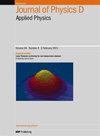Two orientation effects and large anisotropy of parameters in piezo-active 2–1–2 composites based on [0 1 1]-poled crystals
IF 3.2
3区 物理与天体物理
Q2 PHYSICS, APPLIED
引用次数: 0
Abstract
The results of a comparative study on piezo-active 2–1–2 composites with two ferroelectric components are discussed. The composite structure combines elements of 2–2 (laminar) and 1–3 (fibrous) connectivity patterns. The first component in each composite is domain-engineered [0 1 1]-poled single crystal with macroscopic mm2 symmetry and high piezoelectric activity. The second component is a poled ferroelectric ceramic that is represented by parallel rods in the shape of an elliptic cylinder with a large ratio of semi-axes at its base. The first orientation effect is appreciable due to rotations of the main crystallographic axes X and Y around Z || OX3 by an angle α in each crystal layer. Rotation of the ceramic rod bases by an angle γ in a polymer medium leads to the second orientation effect in the 2–1–2 composite. The two orientation effects contribute to a large anisotropy of electromechanical coupling factors , energy-harvesting figures of merit (FOM) and modified FOM for a stress-driven harvester. The large level of , , and (these parameters are of the order of 10−11–10−10 Pa−1) indicates that the studied composites are suitable for piezoelectric sensors, transducers and energy-harvesting systems. New m—α diagrams put forward in the present study show regions wherein the large anisotropy of the effective parameters ( / , )2 and , f = 1 and 2) is achieved when changing the volume fraction m of the single crystal and the rotation angle α. As a result, the leading role of the first orientation effect is emphasised.基于 [0 1 1] 泊尔晶体的压电活性 2-1-2 复合材料中的两种取向效应和参数的大各向异性
本文讨论了对含有两种铁电成分的压电活性 2-1-2 复合材料进行比较研究的结果。复合材料结构结合了 2-2(层状)和 1-3(纤维状)连接模式的元素。每种复合材料的第一种成分是畴工程[0 1 1]极化单晶,具有宏观 mm2 对称性和高压电活性。第二种成分是极化铁电陶瓷,它由平行棒组成,呈椭圆柱状,底部的半轴比很大。由于每个晶体层中的主要晶体学轴 X 和 Y 围绕 Z || OX3 旋转了 α 角,因此第一种取向效应非常明显。陶瓷棒基在聚合物介质中旋转 γ 角导致了 2-1-2 复合材料中的第二种取向效应。这两种取向效应导致机电耦合系数、能量收集功勋值(FOM)和应力驱动收集器的修正 FOM 存在较大的各向异性。较大的、、和(这些参数的数量级为 10-11-10-10 Pa-1)表明,所研究的复合材料适用于压电传感器、换能器和能量收集系统。本研究提出的新 m-α 图显示,当改变单晶体的体积分数 m 和旋转角度 α 时,有效参数 ( / , )2 和 , f = 1 和 2) 的大各向异性区域。因此,第一取向效应的主导作用得到了强调。
本文章由计算机程序翻译,如有差异,请以英文原文为准。
求助全文
约1分钟内获得全文
求助全文
来源期刊
CiteScore
6.80
自引率
8.80%
发文量
835
审稿时长
2.1 months
期刊介绍:
This journal is concerned with all aspects of applied physics research, from biophysics, magnetism, plasmas and semiconductors to the structure and properties of matter.

 求助内容:
求助内容: 应助结果提醒方式:
应助结果提醒方式:


